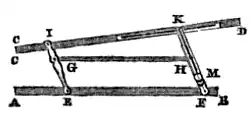Centrolinead
The centrolinead was invented by Peter Nicholson, a British mathematician and architect, in 1814.[1] It was used to construct 2-point perspective drawings where one or both vanishing points existed outside the drawing board. Draftsmen could use the instrument in pairs; one for each vanishing point on each side of the station point.

Centrolineads were produced in various sizes. Typically a brass fitting clamped the wooden arms together. Fittings were produced in both right and left-handed configuration, and certain adjustable designs could be used on either side.
Usage
Two short arms are set to form 90 degree angles against a third, longer drawing edge. Pins are placed near the edges of the drawing surface and serve as pivots for the arms. Pin placement is equidistant and symmetric across the horizontal line. A third centrolinead could be used to construct 3-point perspective.
The diagram shown above does not represent the centrolinead designed by Nicholson.
Further reading
- Centrolineads and their use are discussed in W.F. Stanley's book on mathematical instruments.
- Davy, Sir Humphry; Survey, U. S. Coast and Geodetic. The collected works of Sir Humphry Davy ...: Discourses delivered before the Royal society. Elements of agricultural chemistry, pt. I. Smith, Elder and Company. pp. 725–728.
References
- Bradley, Thomas. Practical Geometry, Linear Perspective, and Projection: Including Isometrical Perspective, Projections of the Sphere, and the Projection of Shadows, with Descriptions of the Principal Instruments Used in Geometrical Drawing, &c. ... For the Use of Artists, Architects ... &c. Baldwin and Cradock. pp. 42–43. Retrieved May 26, 2016.